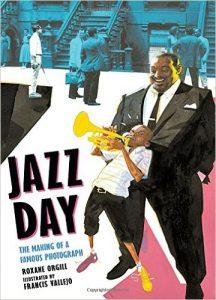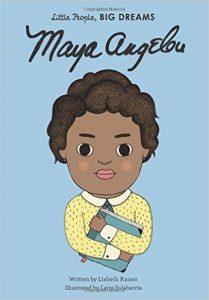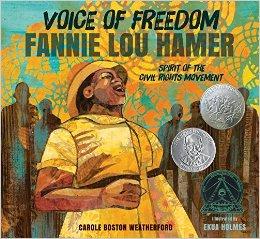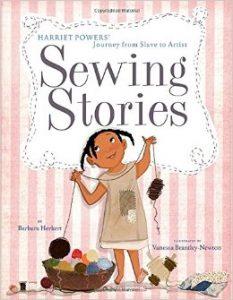Posted by Mari on Friday, Feb 10, 2017
 February has been a busy month for the Children’s Room. Well, it’s pretty much always a busy time for us, but with Valentine’s Day, the 1,000 Books Before Kindergarten anniversary, and the One Book, Two Book festival coming up, we wanted to be sure to offer some great programs and resources for children to learn about black history in our country. For upcoming programs for kids and adults, see our Black History Month series in the calendar. And be sure to check our Black History Month book display and the Behind the Beat: African American Music display by the African American Museum of Iowa, both located in the Children’s Room. Here are some of my favorite newer nonfiction books I’ve been reading this month to learn more.
February has been a busy month for the Children’s Room. Well, it’s pretty much always a busy time for us, but with Valentine’s Day, the 1,000 Books Before Kindergarten anniversary, and the One Book, Two Book festival coming up, we wanted to be sure to offer some great programs and resources for children to learn about black history in our country. For upcoming programs for kids and adults, see our Black History Month series in the calendar. And be sure to check our Black History Month book display and the Behind the Beat: African American Music display by the African American Museum of Iowa, both located in the Children’s Room. Here are some of my favorite newer nonfiction books I’ve been reading this month to learn more.

Jazz Day: The Making of a Famous Photograph by Roxanne Orgill, illustrated by Francis Vallejo
In 1958, Esquire magazine was planning a special issue focused on American jazz. Art Kane, a graphic designer in New York City, put out the word to jazz musicians to gather for a photo but he had no idea how many musicians would show up. The poems in this book were all inspired by a single photograph taken in front of a Harlem brownstone. The book features a large foldout of the infamous photo.
Many of the poems feature the stories of famous jazz musicians’ arrival to the photoshoot, including Thelonious Monk and Dizzy Gillespie, and one poem noting Duke Ellington’s palpable absence. And finally, Vallejo’s vibrant paintings capture the essence of jazz music perfectly.
 Maya Angelou by Lisbeth Kaiser; illustrated by Leire Salaberria.
Maya Angelou by Lisbeth Kaiser; illustrated by Leire Salaberria.
I really enjoy finding biographies that read like short picture books that could hold the attention of young readers, and they are usually hard to find. Maya Angelou is one among a biography series we have called Little People, Big Dreams which delivers access into the lives of other great achievers such as Frida Kahlo and Amelia Earhart for the youngest readers. I appreciate how this biography is sieved down to only the most influential moments of Maya Angelou’s life. The vibrant illustrations have small details that contribute to the story, such as a protest pin on the shirt of a background character or the tiny titles on the books Maya was influenced by as a title.
How to Build a Museum: Smithsonian's National Museum of African American History and Culture by Tonya Bolden

Tonya Bolden has written an absorbing chronicle of how all of the ideas, ambitions, and actual objects from the African American community came together in this incredible museum. Includes behind-the-scenes photos of literally "how to build a museum" as well as incredible artifacts accounting the role slavery played in America, the era of segregation, the Civil Rights movement and the continuing effort to eradicate oppression in this country. This book will appeal to those who really enjoy the museum experience.
Voice of Freedom: Fannie Lou Hamer, Spirit of the Civil Rights Movement by Carole Boston Weatherford

Fannie Lou Hamer was the granddaughter of slaves and the youngest of twenty children, but more importantly she was known as the voice of the civil rights movement through her powerful singing and influential, direct rhetoric. Weatherford’s collection of poems powerfully describe her experiences as a child working in the cotton fields, fighting for her vote, motherhood, marches, sit-ins, jail time and police brutality. The story of Fannie’s life is compelling, inspirational and unbelievably applicable in the current political atmosphere. Also available as a DVD, which we will show during our Sunday Fun Day activity for Black History Month on February 19th.
Sewing Stories: Harriet Powers’ Journey from Slave to Artist by Barbara Herkert, illustrated by Vanessa Brantley-Newton

The picture book biography accounts the life of Harriet Powers, born as a slave on a Georgia plantation who learned to sew pictorial quilts to pass down stories because she was not allowed to learn to read or write. Harriet never left Georgia in her lifetime, but her quilts are now priceless examples of African American folk art. Photos of fabric scraps and Harriet’s quilt stories are sprinkled throughout the illustrations and the details can be examined on the end pages. Herkert included Harriet’s explanations of each patch on her quilts, and provides short bits of historical context throughout the story as well.


I'll admit I placed this book on hold without reading the description solely because I was intrigued by the cover. It ended up being a little different than what I expected, which I think was probably a little like the movie Bad Times at the El Royale, but while it did leave some to be desired in the category of character development, it was an intriguing story with ghosts, detective work, and female empowerment. -Mari